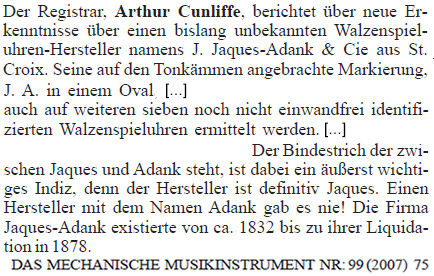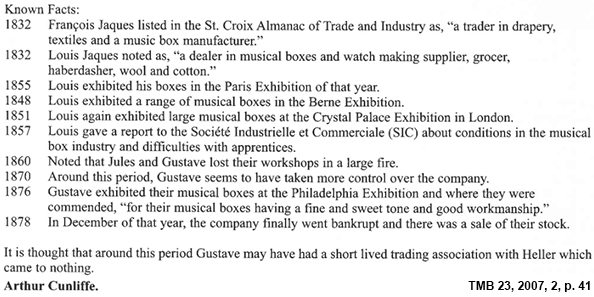|
“François Jaques / François Jaques & Fils” (1831–1852) Louis Jaques et fils” (1832–1860s) J[ules] Jaques-Adank & Cie.” (1860s–1878) “François Jaques / François Jaques & Fils” (1831–1852) François Jaques (before 1831 dealer of drapery and textiles, music box maker) / François Jaques et fils “The industrial survey of 1831 carried out in Sainte-Croix, as well as the Almanac of Trade and industry of 1832, listed François Jaques as one of the main traders in the village [Sainte-Croix]: ‘drapery [Vorhänge], textiles and music box manufacturer’, according to the Almanac.” “François Jaques was one of the pioneers of music box industry. He set up one of the first factories using hydraulic power at the Miguet. He was still active in 1852, under the trade name Jaques F. et Fils.” „Jacques, Louis, & Son, Le Brassus, Switzerland. Were makers of large musical boxes in 1850. Their name is sometimes misspelled `Jaques´.“ Louis Jaques et Fils (1832–February 1858) (etablisseur, dealer in music boxes, grocer, [Gemischtwarenhändler, Krämer (deutsch), Greisler (österr. und bayr.), Fragner (österr. und bayr.), Händler von „kurzen Waren“ (gemeint: kleinen Gegenständen für den Nähbedarf), Kurzwarenhändler, „Kurzwaren“ waren das Gegenteil der Ellenwaren, Betreiber einer „mercerie“ (scheizerisch)], since February 1858 concentrating on watchmaking and music boxes “Louis Jaques was one of the first établisseurs in Sainte-Croix to manufacture and sell music boxes. In 1832, he called himself ‘dealer in music boxes and watchmaking supplies, grocer, haberdasher (Kurzwarenhändler), wool and cotton.’” (Piguet 2004, p. 235-237) “Like most of his colleagues, he traded in the ususal commodities and held a comptoir to ensure the manufacture, assembly and sale of music boxes. Like them also, he sold supplies to specialized Louis Jaques et Fils (i.e. Jules and Gustave) was the second manufacturer in Sainte-Croix, after Abraham-Louis Cuendet in 1833, to show his products [...] in Bern for the second Exhibition of Swiss Industrial Products where their stand included six music boxes playing from three to four tunes.” (Piguet 2004, p. 235-237) Music Boxes shown by Louis Jaques et fils at the 1848 Exhibition in Bern “On this occasion, Louis Jaques wrote to the organizers that music boxes ‘have been produced in our village for a long time and attain a high degreee of perfection. We request you to pay particular attention to the box called Mandolin in which we have tried to imitate the instrument called a mandolin, with sucess. It is a development which we believe we have to bring to your notice.’” “‘We hope that you will consider the articles we are sending you as being part of both fine arts and industry.’ In a post-scriptum he added that ‘the boxes and raw materials are of foreign origin’”. “Louis Jaques´ request did not fall on deaf ears, for the experts highlighted his products as ‘playing beautifully and harmoniously, with a pleasant rhythm’ … however without going to the length of awarding him a medal.” “Three years later, Louis Jaques went to London for the Exhibition of Industrial Products from all Nations where he exhibited, together with mermod Frères, Paillard & Co., and Jaccard Frères, large music boxes playing eight tunes with piano and mandolin, from 120 to 400 francs.” (Piguet 2004, p. 235-237) “And in 1855, the company participated in the Exposition universelle in Paris, after which it specialized in music box manufacture.” (Piguet 2004, p. 235-237) “On 5th December 1857, Jules and Gustave Jaques, who were brothers, wanted to concentrate exclusively on watchmaking and music boxes.. They therefore tried to get rid of their shop, which was sold in February 1858 and taken over by Louis Mutrux-Joseph.” (Piguet 2004, p. 235-237) “On 4th March 1860, the Jaques brothers´ business was destroyed in a raging fire, which forced them to take refuge temporarily with Mr. Fritz Joseph, engraver. The following year they moved to premises on the second floor of the house of Jaccard-Berthier, in the neighborhood of La Conversion.” (Piguet 2004, p. 235-237) Jaques Adank “J. Jaques-Adank & Cie” (Ord-Hume, Musical Boxes, p. 291)
Managing directos where the two brothers, Jules and Gustave Jaques, Madame Adank became the wife of Gustave Jaques and therefore here name came in the designation of the firm.
“During the 1860s, the company was progressively taken over by the two brothers [Jules and Gustave ] and changed its name to J. Jaques-Adank & Cie., i.e. Jules Jaques given name and Adank, the name of his sister-in-law.” (Piguet 2004, p. 235-237) “Jules Jaques was one of the founders of the SIC (Sociéte industrielle et commerciale) in which he was actively involved; for example in writing a report on the need to improve apprenticeship training, to increase sales prices for music and snuffboxes and to create a factory for music box blanks in Sainte-Croix. He very convincingly defended this last project. It would maintain in Sainte-Croix the 150,000 francs´ worth of supplies bought in Geneva.” (Piguet 2004, p. 235-237) “In the 1870s, the company was managed by Gustave Jaques. Its products were of a high standard. They exhibited at the World Exhibition in Philadelphia in 1876, [...]. Gustave Jaques-Adank presented in America an expressive mandolin music box and a mandolin with zither, which earned him a medal (...).” (Piguet 2004, p. 235-237) “The economic crisis prevailing in the country did not spare them and Gustave Jaques was forced to declare bankruptcy, an event which did not go unnoticed and which preoccupied most of the music box manufacturers. They believed that Jaques had contacts with a music box blanks factory in Bern that wanted to convert to making finished boxes. So on 29th August 1878, the music box manufacturers of Sainte-Croix, at the specific request of two of them, met in order to dissuade Gustave Jaques-Adank from organizing a music box blanks factory in Bern, under the patronage of Heller.” (Piguet 2004, p. 235-237) “Sixteen manufacturers, some of whom were in partnership, responded to the appeal, which means that the number does not correspond exactly to the number of our music box factories. However, the chairman, after explaining the case clearly and categorically, emphasized the need to protest if possible against the fact that our industry, which already suffers greatly from consistent competition from Ste-Suzanne and from Teufenthal, has to deal with a new factory in Bern and cordially invites members to use their influence to ward off this danger. Many voices and in the end a committee was designated, composed of Messrs. Amédée Paillard, Arthur Jeanrenaud and Louis-Justin Jaccard.” (SIC Minutes 18) (Piguet 2004, p. 235-237) 1878: Sale of the bankrupt J. Jaques-Adank company “Meanwhile Gustave Jaques left for Concise to join Mr. Eugène Payot and conducted some business there until November 1878. On 12th December, the sale of the bankrupt J. Jaques-Adank company marked its demise.“ (Piguet 2004, p. 235-237)
Siehe Bremond Nr. 189, wo auch ein Flötenwerk von Siehe auch Heller 4301 (Seriennummer 13661) Siehe auch einen unnummerierten, leider ausgebauten Automaten TMB 18, 5, 1998, p. 136, Nr. 26; Bellamy, Music Makers of Switzerland, (2015), p. 6
|




